PhD Thesis Summary: Information Processing, Anxiety, and Cognition
VerifiedAdded on 2021/06/17
|34
|10399
|104
Thesis and Dissertation
AI Summary
This PhD thesis summary investigates the relationship between information processing speed, anxiety levels (particularly non-clinical anxiety), and various cognitive functions in both older and younger adults. The research aims to evaluate the impact of anxiety on attention, reaction time (RT), intra-individual reaction time variability (IIVRT), and other brain functions. The study also explores the influence of sleep quality, demographics, and subjective memory complaints on the relationship between anxiety and cognitive performance. A multi-methodological approach, including questionnaires, pen-and-paper tests, and electronic psychophysics tests, is used to assess these factors. The research questions address how subclinical anxiety affects brain functions, vision, memory, and lifestyle, and whether there are differences between older and younger adults. The introduction highlights the importance of information processing speed and attention in diagnosing dementia and the potential influence of anxiety on these functions. The summary defines anxiety and discusses its types (state and trait anxiety), emphasizing the need for a deeper understanding of how anxiety levels affect essential brain functions. The research seeks to provide recommendations for the evaluation, treatment, and reduction of non-clinical anxiety among older patients.
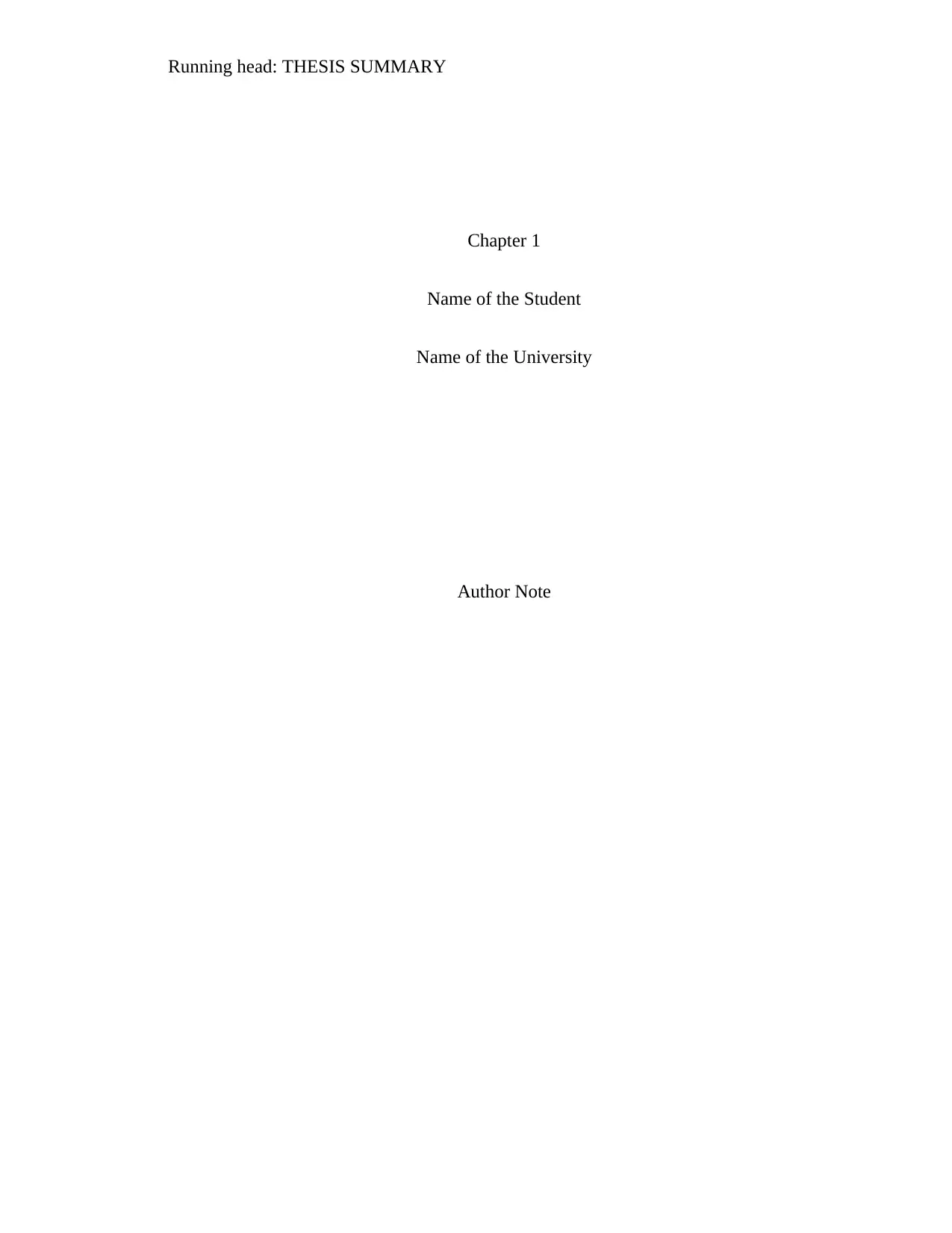
Running head: THESIS SUMMARY
Chapter 1
Name of the Student
Name of the University
Author Note
Chapter 1
Name of the Student
Name of the University
Author Note
Paraphrase This Document
Need a fresh take? Get an instant paraphrase of this document with our AI Paraphraser
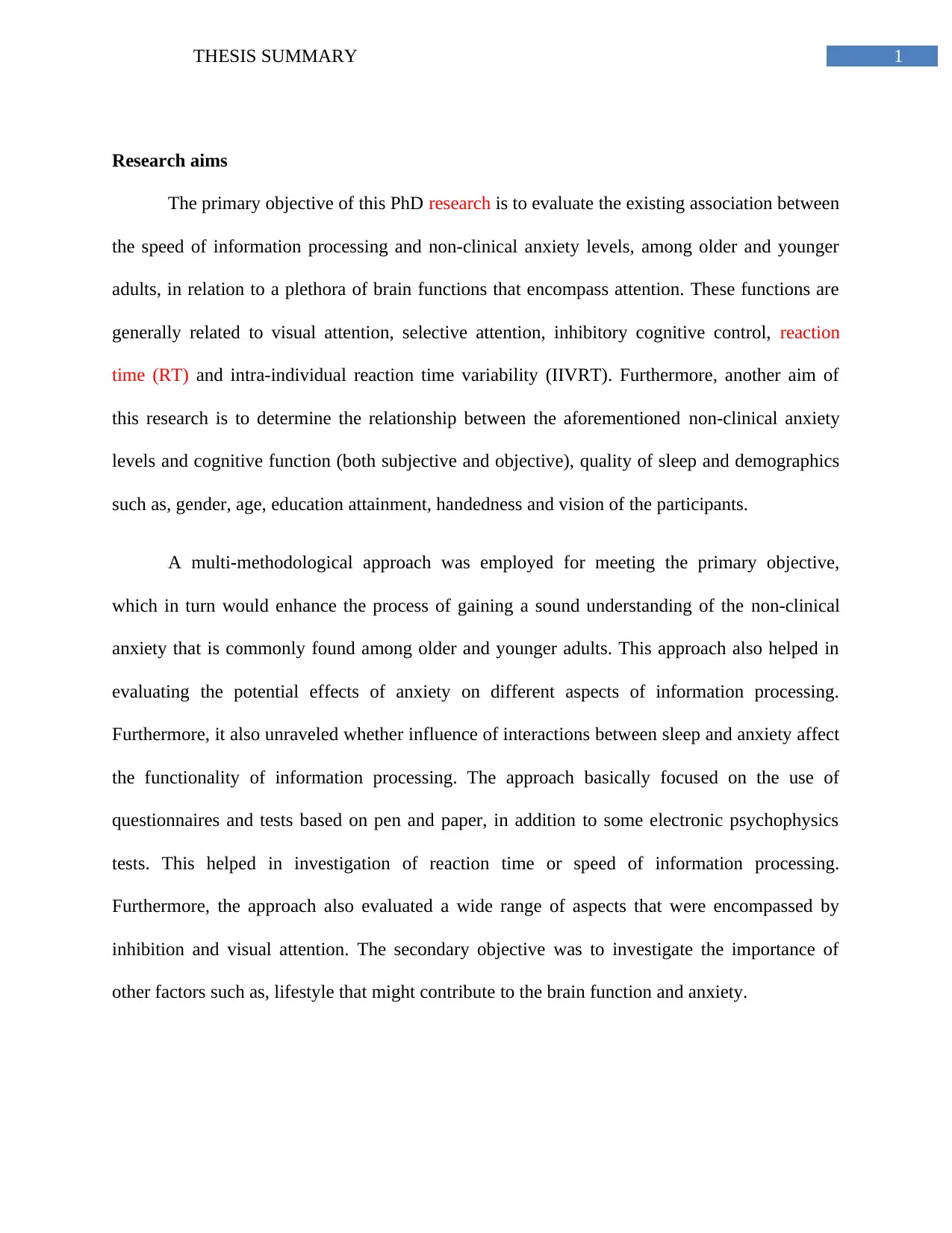
1THESIS SUMMARY
Research aims
The primary objective of this PhD research is to evaluate the existing association between
the speed of information processing and non-clinical anxiety levels, among older and younger
adults, in relation to a plethora of brain functions that encompass attention. These functions are
generally related to visual attention, selective attention, inhibitory cognitive control, reaction
time (RT) and intra-individual reaction time variability (IIVRT). Furthermore, another aim of
this research is to determine the relationship between the aforementioned non-clinical anxiety
levels and cognitive function (both subjective and objective), quality of sleep and demographics
such as, gender, age, education attainment, handedness and vision of the participants.
A multi-methodological approach was employed for meeting the primary objective,
which in turn would enhance the process of gaining a sound understanding of the non-clinical
anxiety that is commonly found among older and younger adults. This approach also helped in
evaluating the potential effects of anxiety on different aspects of information processing.
Furthermore, it also unraveled whether influence of interactions between sleep and anxiety affect
the functionality of information processing. The approach basically focused on the use of
questionnaires and tests based on pen and paper, in addition to some electronic psychophysics
tests. This helped in investigation of reaction time or speed of information processing.
Furthermore, the approach also evaluated a wide range of aspects that were encompassed by
inhibition and visual attention. The secondary objective was to investigate the importance of
other factors such as, lifestyle that might contribute to the brain function and anxiety.
Research aims
The primary objective of this PhD research is to evaluate the existing association between
the speed of information processing and non-clinical anxiety levels, among older and younger
adults, in relation to a plethora of brain functions that encompass attention. These functions are
generally related to visual attention, selective attention, inhibitory cognitive control, reaction
time (RT) and intra-individual reaction time variability (IIVRT). Furthermore, another aim of
this research is to determine the relationship between the aforementioned non-clinical anxiety
levels and cognitive function (both subjective and objective), quality of sleep and demographics
such as, gender, age, education attainment, handedness and vision of the participants.
A multi-methodological approach was employed for meeting the primary objective,
which in turn would enhance the process of gaining a sound understanding of the non-clinical
anxiety that is commonly found among older and younger adults. This approach also helped in
evaluating the potential effects of anxiety on different aspects of information processing.
Furthermore, it also unraveled whether influence of interactions between sleep and anxiety affect
the functionality of information processing. The approach basically focused on the use of
questionnaires and tests based on pen and paper, in addition to some electronic psychophysics
tests. This helped in investigation of reaction time or speed of information processing.
Furthermore, the approach also evaluated a wide range of aspects that were encompassed by
inhibition and visual attention. The secondary objective was to investigate the importance of
other factors such as, lifestyle that might contribute to the brain function and anxiety.
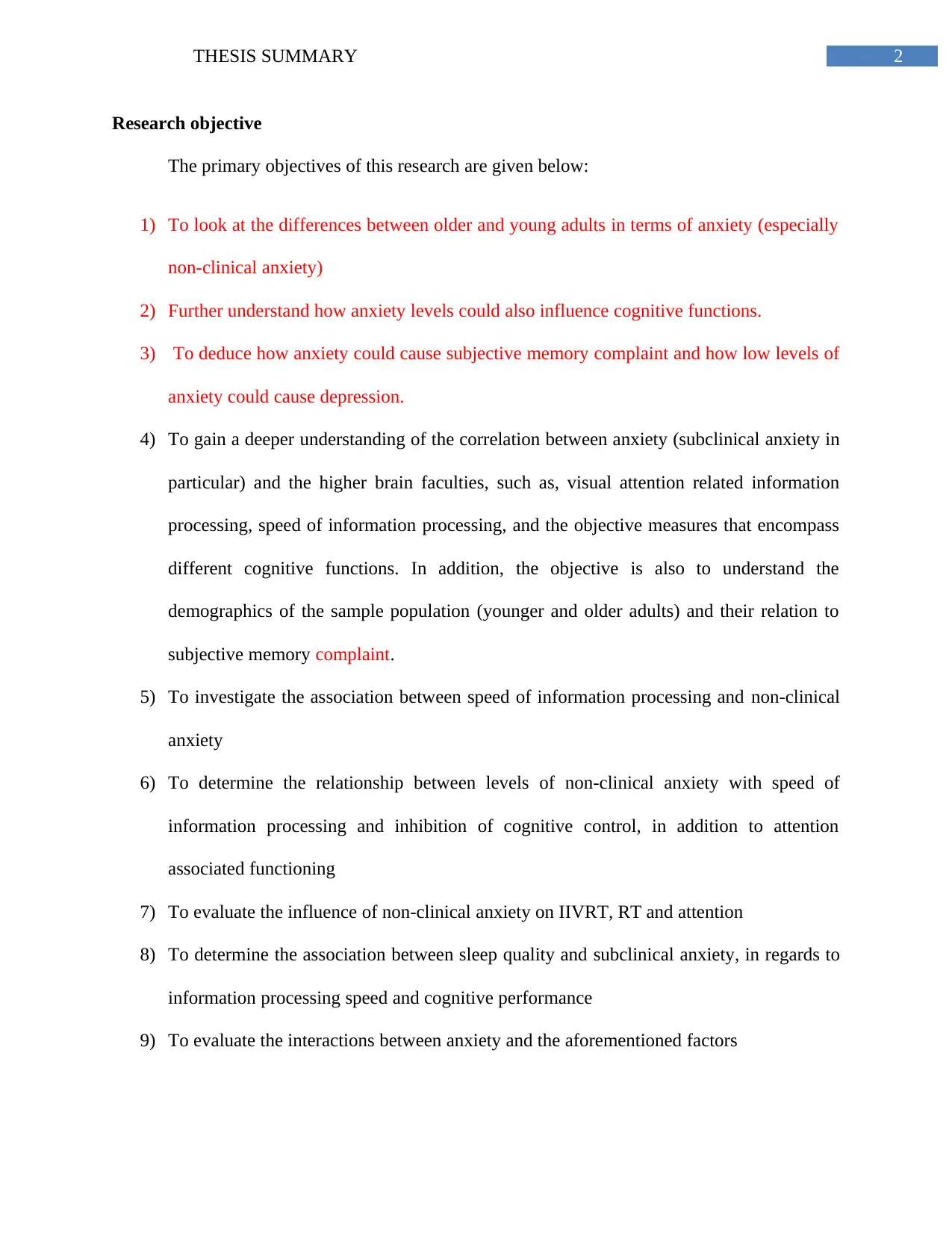
2THESIS SUMMARY
Research objective
The primary objectives of this research are given below:
1) To look at the differences between older and young adults in terms of anxiety (especially
non-clinical anxiety)
2) Further understand how anxiety levels could also influence cognitive functions.
3) To deduce how anxiety could cause subjective memory complaint and how low levels of
anxiety could cause depression.
4) To gain a deeper understanding of the correlation between anxiety (subclinical anxiety in
particular) and the higher brain faculties, such as, visual attention related information
processing, speed of information processing, and the objective measures that encompass
different cognitive functions. In addition, the objective is also to understand the
demographics of the sample population (younger and older adults) and their relation to
subjective memory complaint.
5) To investigate the association between speed of information processing and non-clinical
anxiety
6) To determine the relationship between levels of non-clinical anxiety with speed of
information processing and inhibition of cognitive control, in addition to attention
associated functioning
7) To evaluate the influence of non-clinical anxiety on IIVRT, RT and attention
8) To determine the association between sleep quality and subclinical anxiety, in regards to
information processing speed and cognitive performance
9) To evaluate the interactions between anxiety and the aforementioned factors
Research objective
The primary objectives of this research are given below:
1) To look at the differences between older and young adults in terms of anxiety (especially
non-clinical anxiety)
2) Further understand how anxiety levels could also influence cognitive functions.
3) To deduce how anxiety could cause subjective memory complaint and how low levels of
anxiety could cause depression.
4) To gain a deeper understanding of the correlation between anxiety (subclinical anxiety in
particular) and the higher brain faculties, such as, visual attention related information
processing, speed of information processing, and the objective measures that encompass
different cognitive functions. In addition, the objective is also to understand the
demographics of the sample population (younger and older adults) and their relation to
subjective memory complaint.
5) To investigate the association between speed of information processing and non-clinical
anxiety
6) To determine the relationship between levels of non-clinical anxiety with speed of
information processing and inhibition of cognitive control, in addition to attention
associated functioning
7) To evaluate the influence of non-clinical anxiety on IIVRT, RT and attention
8) To determine the association between sleep quality and subclinical anxiety, in regards to
information processing speed and cognitive performance
9) To evaluate the interactions between anxiety and the aforementioned factors
⊘ This is a preview!⊘
Do you want full access?
Subscribe today to unlock all pages.

Trusted by 1+ million students worldwide
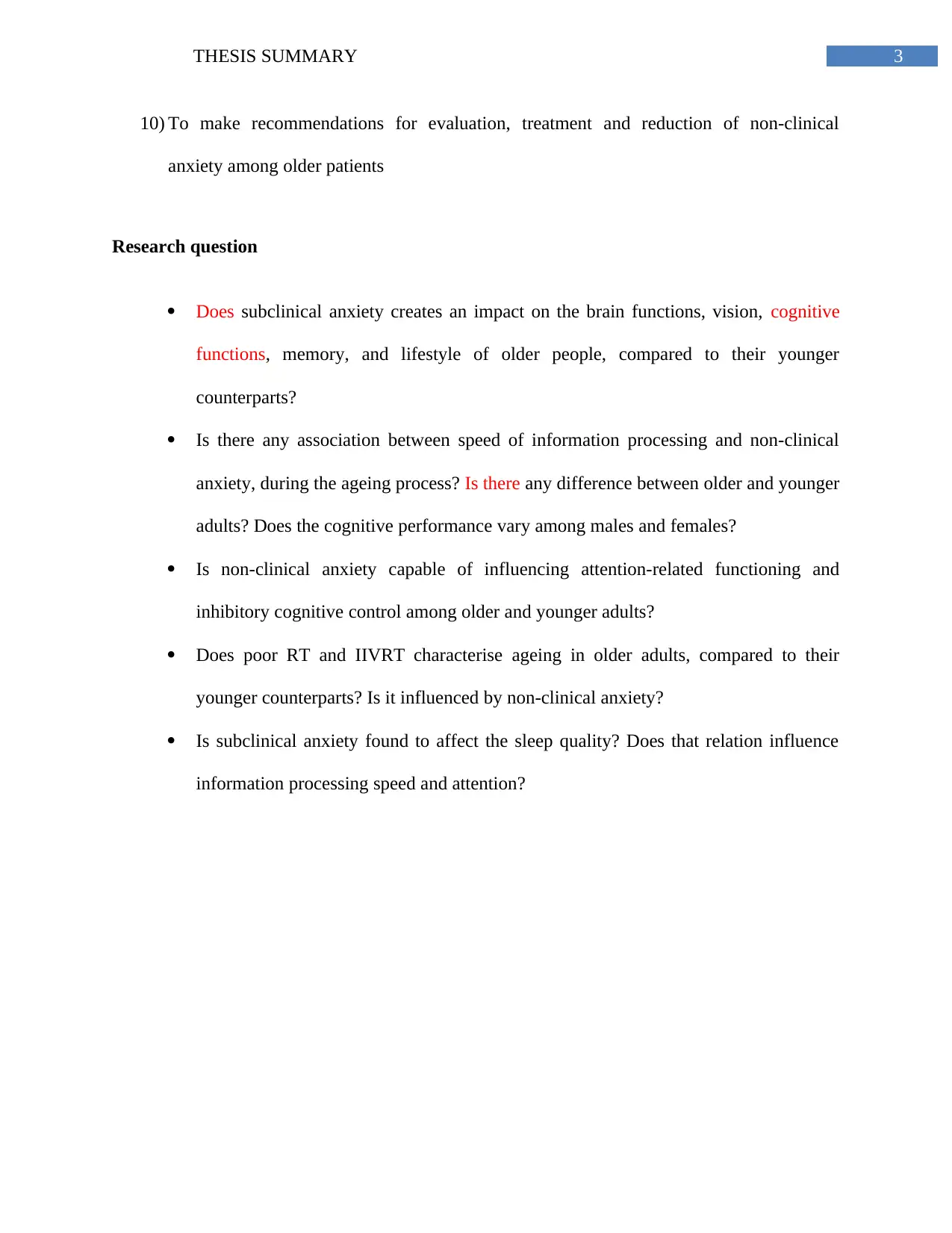
3THESIS SUMMARY
10) To make recommendations for evaluation, treatment and reduction of non-clinical
anxiety among older patients
Research question
Does subclinical anxiety creates an impact on the brain functions, vision, cognitive
functions, memory, and lifestyle of older people, compared to their younger
counterparts?
Is there any association between speed of information processing and non-clinical
anxiety, during the ageing process? Is there any difference between older and younger
adults? Does the cognitive performance vary among males and females?
Is non-clinical anxiety capable of influencing attention-related functioning and
inhibitory cognitive control among older and younger adults?
Does poor RT and IIVRT characterise ageing in older adults, compared to their
younger counterparts? Is it influenced by non-clinical anxiety?
Is subclinical anxiety found to affect the sleep quality? Does that relation influence
information processing speed and attention?
10) To make recommendations for evaluation, treatment and reduction of non-clinical
anxiety among older patients
Research question
Does subclinical anxiety creates an impact on the brain functions, vision, cognitive
functions, memory, and lifestyle of older people, compared to their younger
counterparts?
Is there any association between speed of information processing and non-clinical
anxiety, during the ageing process? Is there any difference between older and younger
adults? Does the cognitive performance vary among males and females?
Is non-clinical anxiety capable of influencing attention-related functioning and
inhibitory cognitive control among older and younger adults?
Does poor RT and IIVRT characterise ageing in older adults, compared to their
younger counterparts? Is it influenced by non-clinical anxiety?
Is subclinical anxiety found to affect the sleep quality? Does that relation influence
information processing speed and attention?
Paraphrase This Document
Need a fresh take? Get an instant paraphrase of this document with our AI Paraphraser

4THESIS SUMMARY
Introduction
Speed of information processing is generally considered as an essential aspect of
dementia and ageing that facilitates the process of clinically diagnosing dementia. This
processing speed can therefore be defined as the cognitive ability that helps to understand
responds to particular information that is received, which might include movement, auditory and
visual. The clinical importance of information processing speed has also been illustrated by the
recently revised DSM-5 criteria that elaborate on the fact that processing speed is always
measured in regards of attention-related function that facilitates the process of diagnosing
dementia and its associated conditions (Torrens-Burton et al., 2017). Measurement of processing
speed during the diagnostic procedure is in fact related to the well-defined relationship between
the functional/structural integrity of gray and white matter with the behavioural measures of
speed. The structural integrity has been found to be detrimentally affected among AD patients,
when compared to reduced cognition during normal ageing (Phillips et al., 2013).
However, DSM-V criteria is often vague and fails to define specific information
processing speed test, in addition to MCI or dementia, that might create an influence on the
processing speed. This would bring about significant changes in clinical test results and their
interpretation. Non-clinical anxiety levels have been identified as a potential factor that
influences information processing speed. However, there is lack of supporting evidences for the
same. Several studies have been conducted that took clinical anxiety into account and
investigated its association with the speed of information processing. This provided evidence for
the association between high levels of anxiety and their subsequent impacts on brain functions
(Tobias, 2013). However, a flaw in the research studies were that low anxiety levels in older and
Introduction
Speed of information processing is generally considered as an essential aspect of
dementia and ageing that facilitates the process of clinically diagnosing dementia. This
processing speed can therefore be defined as the cognitive ability that helps to understand
responds to particular information that is received, which might include movement, auditory and
visual. The clinical importance of information processing speed has also been illustrated by the
recently revised DSM-5 criteria that elaborate on the fact that processing speed is always
measured in regards of attention-related function that facilitates the process of diagnosing
dementia and its associated conditions (Torrens-Burton et al., 2017). Measurement of processing
speed during the diagnostic procedure is in fact related to the well-defined relationship between
the functional/structural integrity of gray and white matter with the behavioural measures of
speed. The structural integrity has been found to be detrimentally affected among AD patients,
when compared to reduced cognition during normal ageing (Phillips et al., 2013).
However, DSM-V criteria is often vague and fails to define specific information
processing speed test, in addition to MCI or dementia, that might create an influence on the
processing speed. This would bring about significant changes in clinical test results and their
interpretation. Non-clinical anxiety levels have been identified as a potential factor that
influences information processing speed. However, there is lack of supporting evidences for the
same. Several studies have been conducted that took clinical anxiety into account and
investigated its association with the speed of information processing. This provided evidence for
the association between high levels of anxiety and their subsequent impacts on brain functions
(Tobias, 2013). However, a flaw in the research studies were that low anxiety levels in older and
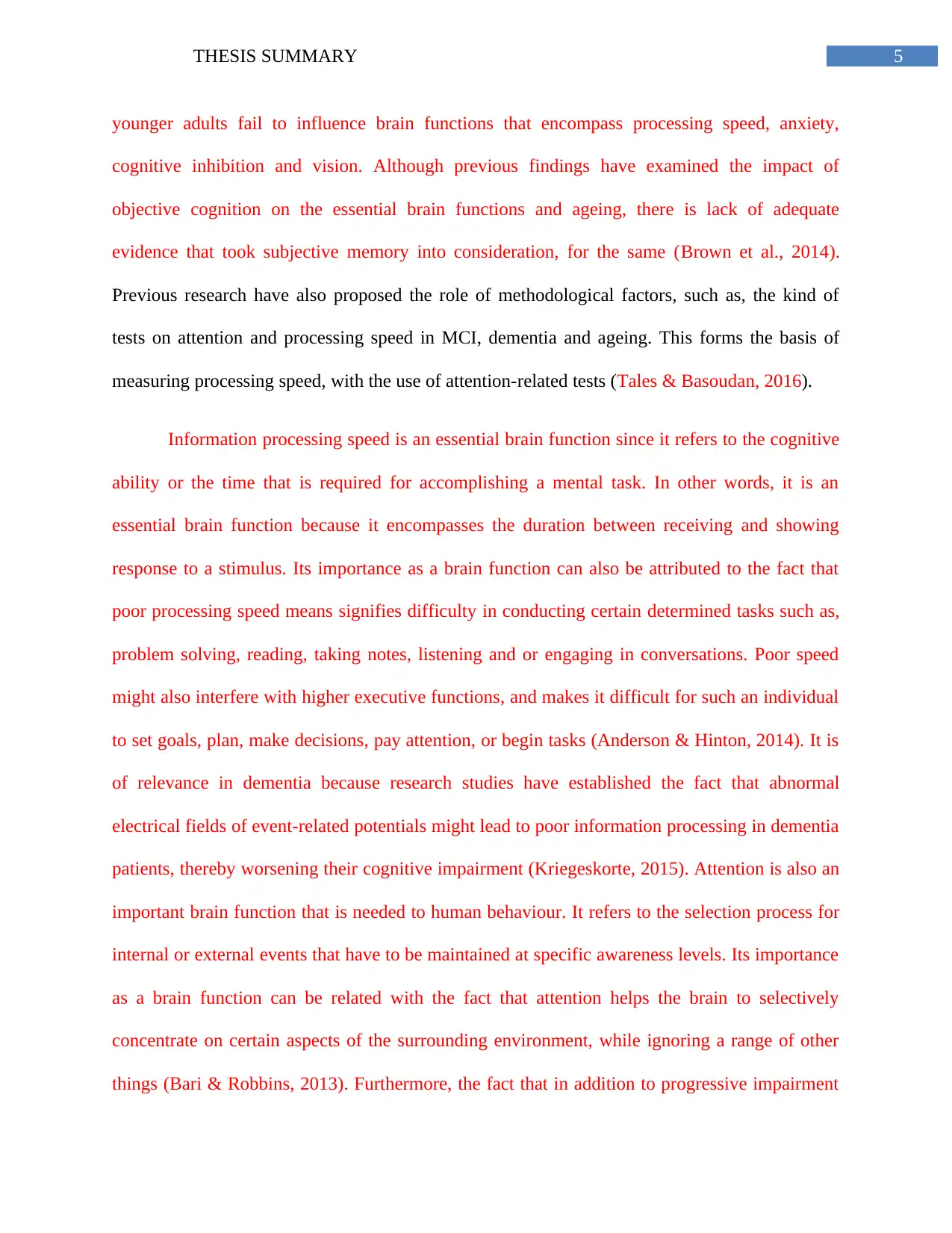
5THESIS SUMMARY
younger adults fail to influence brain functions that encompass processing speed, anxiety,
cognitive inhibition and vision. Although previous findings have examined the impact of
objective cognition on the essential brain functions and ageing, there is lack of adequate
evidence that took subjective memory into consideration, for the same (Brown et al., 2014).
Previous research have also proposed the role of methodological factors, such as, the kind of
tests on attention and processing speed in MCI, dementia and ageing. This forms the basis of
measuring processing speed, with the use of attention-related tests (Tales & Basoudan, 2016).
Information processing speed is an essential brain function since it refers to the cognitive
ability or the time that is required for accomplishing a mental task. In other words, it is an
essential brain function because it encompasses the duration between receiving and showing
response to a stimulus. Its importance as a brain function can also be attributed to the fact that
poor processing speed means signifies difficulty in conducting certain determined tasks such as,
problem solving, reading, taking notes, listening and or engaging in conversations. Poor speed
might also interfere with higher executive functions, and makes it difficult for such an individual
to set goals, plan, make decisions, pay attention, or begin tasks (Anderson & Hinton, 2014). It is
of relevance in dementia because research studies have established the fact that abnormal
electrical fields of event-related potentials might lead to poor information processing in dementia
patients, thereby worsening their cognitive impairment (Kriegeskorte, 2015). Attention is also an
important brain function that is needed to human behaviour. It refers to the selection process for
internal or external events that have to be maintained at specific awareness levels. Its importance
as a brain function can be related with the fact that attention helps the brain to selectively
concentrate on certain aspects of the surrounding environment, while ignoring a range of other
things (Bari & Robbins, 2013). Furthermore, the fact that in addition to progressive impairment
younger adults fail to influence brain functions that encompass processing speed, anxiety,
cognitive inhibition and vision. Although previous findings have examined the impact of
objective cognition on the essential brain functions and ageing, there is lack of adequate
evidence that took subjective memory into consideration, for the same (Brown et al., 2014).
Previous research have also proposed the role of methodological factors, such as, the kind of
tests on attention and processing speed in MCI, dementia and ageing. This forms the basis of
measuring processing speed, with the use of attention-related tests (Tales & Basoudan, 2016).
Information processing speed is an essential brain function since it refers to the cognitive
ability or the time that is required for accomplishing a mental task. In other words, it is an
essential brain function because it encompasses the duration between receiving and showing
response to a stimulus. Its importance as a brain function can also be attributed to the fact that
poor processing speed means signifies difficulty in conducting certain determined tasks such as,
problem solving, reading, taking notes, listening and or engaging in conversations. Poor speed
might also interfere with higher executive functions, and makes it difficult for such an individual
to set goals, plan, make decisions, pay attention, or begin tasks (Anderson & Hinton, 2014). It is
of relevance in dementia because research studies have established the fact that abnormal
electrical fields of event-related potentials might lead to poor information processing in dementia
patients, thereby worsening their cognitive impairment (Kriegeskorte, 2015). Attention is also an
important brain function that is needed to human behaviour. It refers to the selection process for
internal or external events that have to be maintained at specific awareness levels. Its importance
as a brain function can be related with the fact that attention helps the brain to selectively
concentrate on certain aspects of the surrounding environment, while ignoring a range of other
things (Bari & Robbins, 2013). Furthermore, the fact that in addition to progressive impairment
⊘ This is a preview!⊘
Do you want full access?
Subscribe today to unlock all pages.

Trusted by 1+ million students worldwide
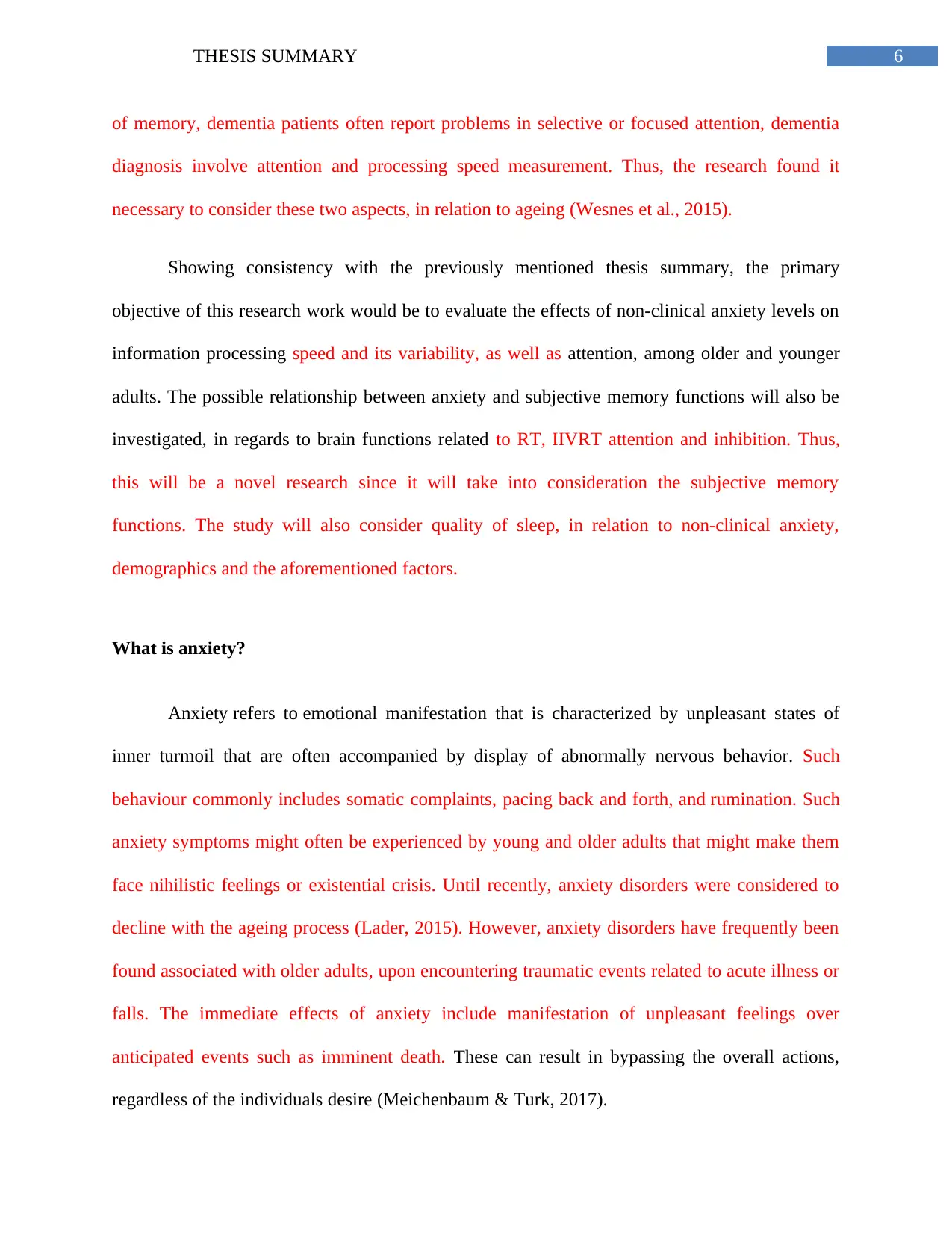
6THESIS SUMMARY
of memory, dementia patients often report problems in selective or focused attention, dementia
diagnosis involve attention and processing speed measurement. Thus, the research found it
necessary to consider these two aspects, in relation to ageing (Wesnes et al., 2015).
Showing consistency with the previously mentioned thesis summary, the primary
objective of this research work would be to evaluate the effects of non-clinical anxiety levels on
information processing speed and its variability, as well as attention, among older and younger
adults. The possible relationship between anxiety and subjective memory functions will also be
investigated, in regards to brain functions related to RT, IIVRT attention and inhibition. Thus,
this will be a novel research since it will take into consideration the subjective memory
functions. The study will also consider quality of sleep, in relation to non-clinical anxiety,
demographics and the aforementioned factors.
What is anxiety?
Anxiety refers to emotional manifestation that is characterized by unpleasant states of
inner turmoil that are often accompanied by display of abnormally nervous behavior. Such
behaviour commonly includes somatic complaints, pacing back and forth, and rumination. Such
anxiety symptoms might often be experienced by young and older adults that might make them
face nihilistic feelings or existential crisis. Until recently, anxiety disorders were considered to
decline with the ageing process (Lader, 2015). However, anxiety disorders have frequently been
found associated with older adults, upon encountering traumatic events related to acute illness or
falls. The immediate effects of anxiety include manifestation of unpleasant feelings over
anticipated events such as imminent death. These can result in bypassing the overall actions,
regardless of the individuals desire (Meichenbaum & Turk, 2017).
of memory, dementia patients often report problems in selective or focused attention, dementia
diagnosis involve attention and processing speed measurement. Thus, the research found it
necessary to consider these two aspects, in relation to ageing (Wesnes et al., 2015).
Showing consistency with the previously mentioned thesis summary, the primary
objective of this research work would be to evaluate the effects of non-clinical anxiety levels on
information processing speed and its variability, as well as attention, among older and younger
adults. The possible relationship between anxiety and subjective memory functions will also be
investigated, in regards to brain functions related to RT, IIVRT attention and inhibition. Thus,
this will be a novel research since it will take into consideration the subjective memory
functions. The study will also consider quality of sleep, in relation to non-clinical anxiety,
demographics and the aforementioned factors.
What is anxiety?
Anxiety refers to emotional manifestation that is characterized by unpleasant states of
inner turmoil that are often accompanied by display of abnormally nervous behavior. Such
behaviour commonly includes somatic complaints, pacing back and forth, and rumination. Such
anxiety symptoms might often be experienced by young and older adults that might make them
face nihilistic feelings or existential crisis. Until recently, anxiety disorders were considered to
decline with the ageing process (Lader, 2015). However, anxiety disorders have frequently been
found associated with older adults, upon encountering traumatic events related to acute illness or
falls. The immediate effects of anxiety include manifestation of unpleasant feelings over
anticipated events such as imminent death. These can result in bypassing the overall actions,
regardless of the individuals desire (Meichenbaum & Turk, 2017).
Paraphrase This Document
Need a fresh take? Get an instant paraphrase of this document with our AI Paraphraser
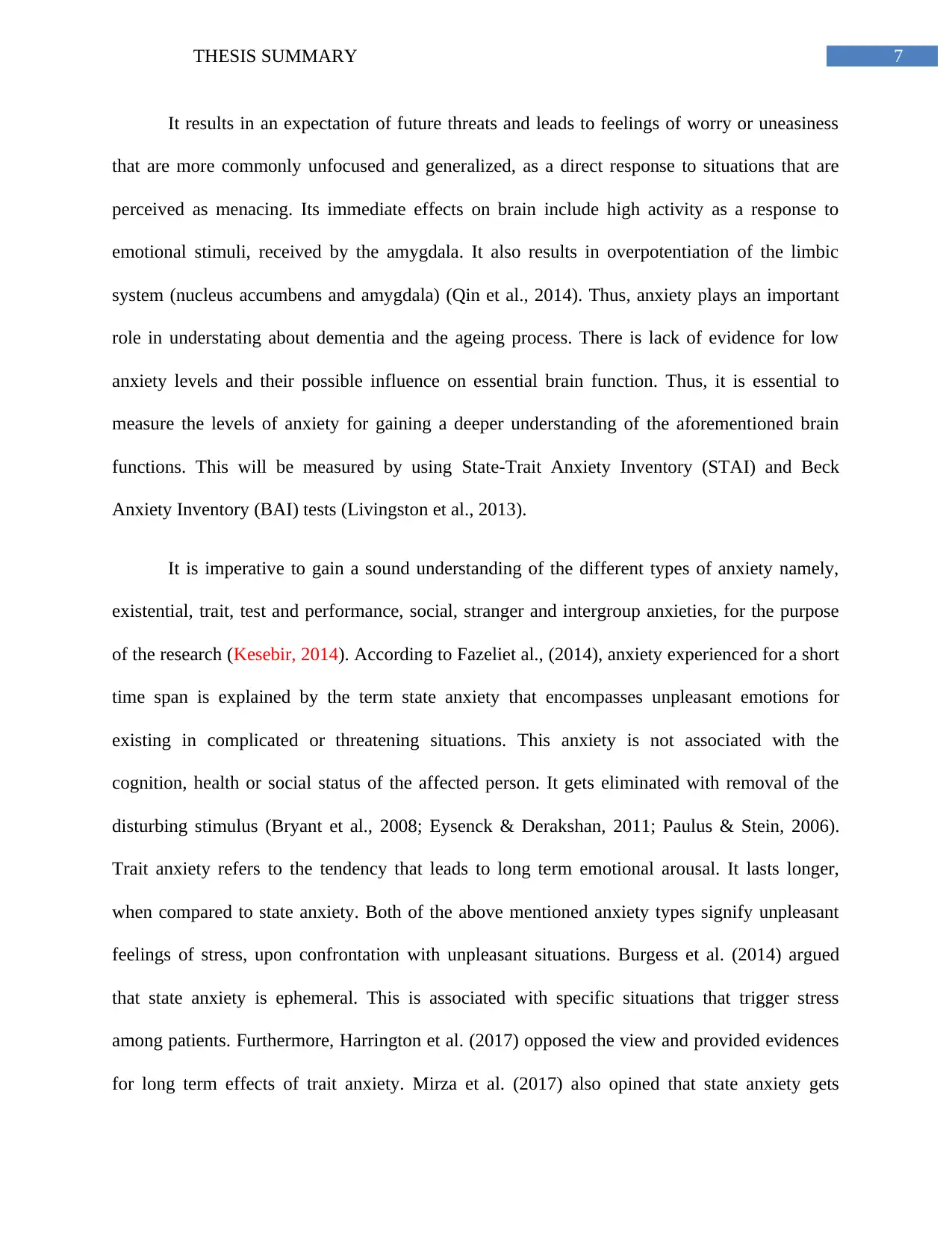
7THESIS SUMMARY
It results in an expectation of future threats and leads to feelings of worry or uneasiness
that are more commonly unfocused and generalized, as a direct response to situations that are
perceived as menacing. Its immediate effects on brain include high activity as a response to
emotional stimuli, received by the amygdala. It also results in overpotentiation of the limbic
system (nucleus accumbens and amygdala) (Qin et al., 2014). Thus, anxiety plays an important
role in understating about dementia and the ageing process. There is lack of evidence for low
anxiety levels and their possible influence on essential brain function. Thus, it is essential to
measure the levels of anxiety for gaining a deeper understanding of the aforementioned brain
functions. This will be measured by using State-Trait Anxiety Inventory (STAI) and Beck
Anxiety Inventory (BAI) tests (Livingston et al., 2013).
It is imperative to gain a sound understanding of the different types of anxiety namely,
existential, trait, test and performance, social, stranger and intergroup anxieties, for the purpose
of the research (Kesebir, 2014). According to Fazeliet al., (2014), anxiety experienced for a short
time span is explained by the term state anxiety that encompasses unpleasant emotions for
existing in complicated or threatening situations. This anxiety is not associated with the
cognition, health or social status of the affected person. It gets eliminated with removal of the
disturbing stimulus (Bryant et al., 2008; Eysenck & Derakshan, 2011; Paulus & Stein, 2006).
Trait anxiety refers to the tendency that leads to long term emotional arousal. It lasts longer,
when compared to state anxiety. Both of the above mentioned anxiety types signify unpleasant
feelings of stress, upon confrontation with unpleasant situations. Burgess et al. (2014) argued
that state anxiety is ephemeral. This is associated with specific situations that trigger stress
among patients. Furthermore, Harrington et al. (2017) opposed the view and provided evidences
for long term effects of trait anxiety. Mirza et al. (2017) also opined that state anxiety gets
It results in an expectation of future threats and leads to feelings of worry or uneasiness
that are more commonly unfocused and generalized, as a direct response to situations that are
perceived as menacing. Its immediate effects on brain include high activity as a response to
emotional stimuli, received by the amygdala. It also results in overpotentiation of the limbic
system (nucleus accumbens and amygdala) (Qin et al., 2014). Thus, anxiety plays an important
role in understating about dementia and the ageing process. There is lack of evidence for low
anxiety levels and their possible influence on essential brain function. Thus, it is essential to
measure the levels of anxiety for gaining a deeper understanding of the aforementioned brain
functions. This will be measured by using State-Trait Anxiety Inventory (STAI) and Beck
Anxiety Inventory (BAI) tests (Livingston et al., 2013).
It is imperative to gain a sound understanding of the different types of anxiety namely,
existential, trait, test and performance, social, stranger and intergroup anxieties, for the purpose
of the research (Kesebir, 2014). According to Fazeliet al., (2014), anxiety experienced for a short
time span is explained by the term state anxiety that encompasses unpleasant emotions for
existing in complicated or threatening situations. This anxiety is not associated with the
cognition, health or social status of the affected person. It gets eliminated with removal of the
disturbing stimulus (Bryant et al., 2008; Eysenck & Derakshan, 2011; Paulus & Stein, 2006).
Trait anxiety refers to the tendency that leads to long term emotional arousal. It lasts longer,
when compared to state anxiety. Both of the above mentioned anxiety types signify unpleasant
feelings of stress, upon confrontation with unpleasant situations. Burgess et al. (2014) argued
that state anxiety is ephemeral. This is associated with specific situations that trigger stress
among patients. Furthermore, Harrington et al. (2017) opposed the view and provided evidences
for long term effects of trait anxiety. Mirza et al. (2017) also opined that state anxiety gets
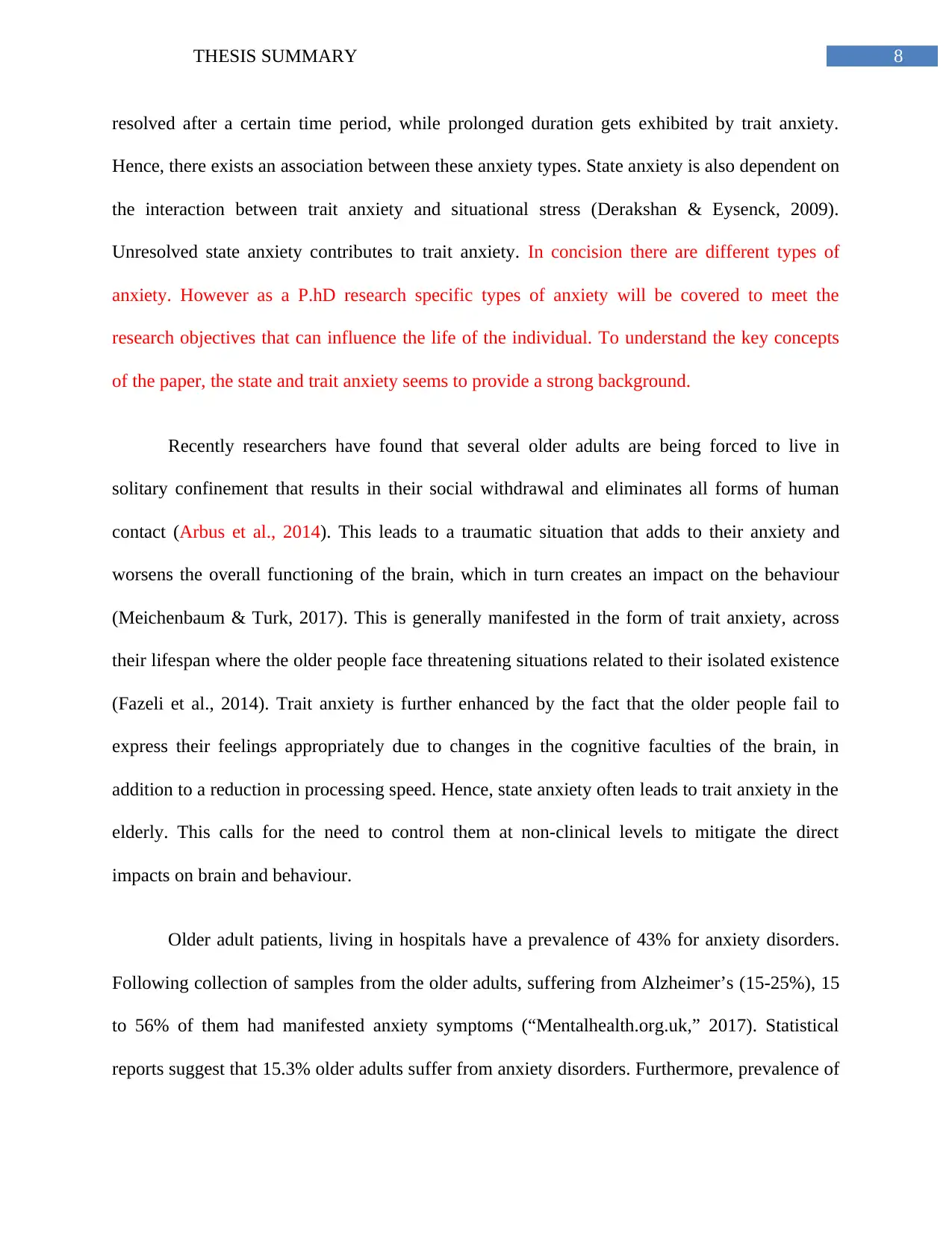
8THESIS SUMMARY
resolved after a certain time period, while prolonged duration gets exhibited by trait anxiety.
Hence, there exists an association between these anxiety types. State anxiety is also dependent on
the interaction between trait anxiety and situational stress (Derakshan & Eysenck, 2009).
Unresolved state anxiety contributes to trait anxiety. In concision there are different types of
anxiety. However as a P.hD research specific types of anxiety will be covered to meet the
research objectives that can influence the life of the individual. To understand the key concepts
of the paper, the state and trait anxiety seems to provide a strong background.
Recently researchers have found that several older adults are being forced to live in
solitary confinement that results in their social withdrawal and eliminates all forms of human
contact (Arbus et al., 2014). This leads to a traumatic situation that adds to their anxiety and
worsens the overall functioning of the brain, which in turn creates an impact on the behaviour
(Meichenbaum & Turk, 2017). This is generally manifested in the form of trait anxiety, across
their lifespan where the older people face threatening situations related to their isolated existence
(Fazeli et al., 2014). Trait anxiety is further enhanced by the fact that the older people fail to
express their feelings appropriately due to changes in the cognitive faculties of the brain, in
addition to a reduction in processing speed. Hence, state anxiety often leads to trait anxiety in the
elderly. This calls for the need to control them at non-clinical levels to mitigate the direct
impacts on brain and behaviour.
Older adult patients, living in hospitals have a prevalence of 43% for anxiety disorders.
Following collection of samples from the older adults, suffering from Alzheimer’s (15-25%), 15
to 56% of them had manifested anxiety symptoms (“Mentalhealth.org.uk,” 2017). Statistical
reports suggest that 15.3% older adults suffer from anxiety disorders. Furthermore, prevalence of
resolved after a certain time period, while prolonged duration gets exhibited by trait anxiety.
Hence, there exists an association between these anxiety types. State anxiety is also dependent on
the interaction between trait anxiety and situational stress (Derakshan & Eysenck, 2009).
Unresolved state anxiety contributes to trait anxiety. In concision there are different types of
anxiety. However as a P.hD research specific types of anxiety will be covered to meet the
research objectives that can influence the life of the individual. To understand the key concepts
of the paper, the state and trait anxiety seems to provide a strong background.
Recently researchers have found that several older adults are being forced to live in
solitary confinement that results in their social withdrawal and eliminates all forms of human
contact (Arbus et al., 2014). This leads to a traumatic situation that adds to their anxiety and
worsens the overall functioning of the brain, which in turn creates an impact on the behaviour
(Meichenbaum & Turk, 2017). This is generally manifested in the form of trait anxiety, across
their lifespan where the older people face threatening situations related to their isolated existence
(Fazeli et al., 2014). Trait anxiety is further enhanced by the fact that the older people fail to
express their feelings appropriately due to changes in the cognitive faculties of the brain, in
addition to a reduction in processing speed. Hence, state anxiety often leads to trait anxiety in the
elderly. This calls for the need to control them at non-clinical levels to mitigate the direct
impacts on brain and behaviour.
Older adult patients, living in hospitals have a prevalence of 43% for anxiety disorders.
Following collection of samples from the older adults, suffering from Alzheimer’s (15-25%), 15
to 56% of them had manifested anxiety symptoms (“Mentalhealth.org.uk,” 2017). Statistical
reports suggest that 15.3% older adults suffer from anxiety disorders. Furthermore, prevalence of
⊘ This is a preview!⊘
Do you want full access?
Subscribe today to unlock all pages.

Trusted by 1+ million students worldwide
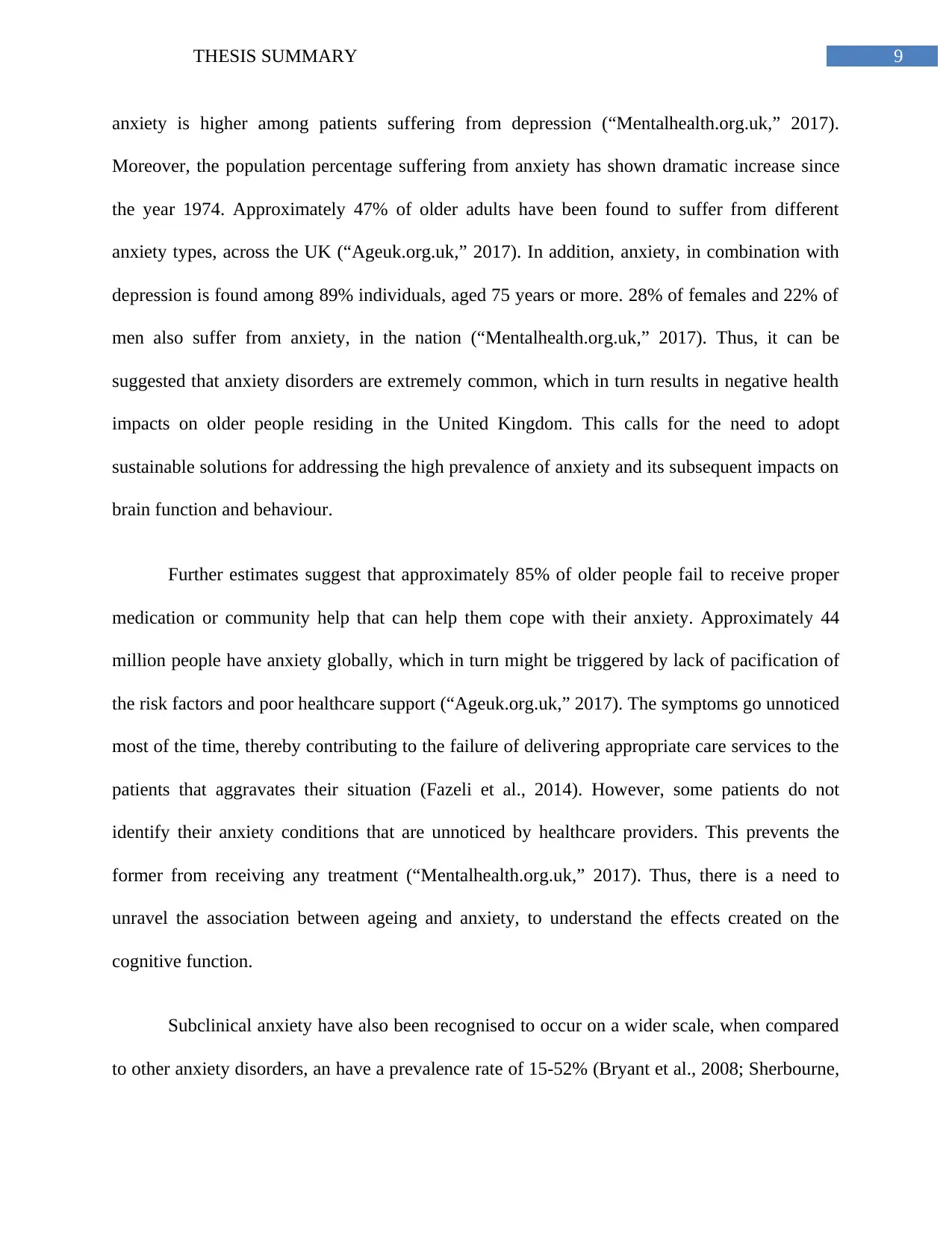
9THESIS SUMMARY
anxiety is higher among patients suffering from depression (“Mentalhealth.org.uk,” 2017).
Moreover, the population percentage suffering from anxiety has shown dramatic increase since
the year 1974. Approximately 47% of older adults have been found to suffer from different
anxiety types, across the UK (“Ageuk.org.uk,” 2017). In addition, anxiety, in combination with
depression is found among 89% individuals, aged 75 years or more. 28% of females and 22% of
men also suffer from anxiety, in the nation (“Mentalhealth.org.uk,” 2017). Thus, it can be
suggested that anxiety disorders are extremely common, which in turn results in negative health
impacts on older people residing in the United Kingdom. This calls for the need to adopt
sustainable solutions for addressing the high prevalence of anxiety and its subsequent impacts on
brain function and behaviour.
Further estimates suggest that approximately 85% of older people fail to receive proper
medication or community help that can help them cope with their anxiety. Approximately 44
million people have anxiety globally, which in turn might be triggered by lack of pacification of
the risk factors and poor healthcare support (“Ageuk.org.uk,” 2017). The symptoms go unnoticed
most of the time, thereby contributing to the failure of delivering appropriate care services to the
patients that aggravates their situation (Fazeli et al., 2014). However, some patients do not
identify their anxiety conditions that are unnoticed by healthcare providers. This prevents the
former from receiving any treatment (“Mentalhealth.org.uk,” 2017). Thus, there is a need to
unravel the association between ageing and anxiety, to understand the effects created on the
cognitive function.
Subclinical anxiety have also been recognised to occur on a wider scale, when compared
to other anxiety disorders, an have a prevalence rate of 15-52% (Bryant et al., 2008; Sherbourne,
anxiety is higher among patients suffering from depression (“Mentalhealth.org.uk,” 2017).
Moreover, the population percentage suffering from anxiety has shown dramatic increase since
the year 1974. Approximately 47% of older adults have been found to suffer from different
anxiety types, across the UK (“Ageuk.org.uk,” 2017). In addition, anxiety, in combination with
depression is found among 89% individuals, aged 75 years or more. 28% of females and 22% of
men also suffer from anxiety, in the nation (“Mentalhealth.org.uk,” 2017). Thus, it can be
suggested that anxiety disorders are extremely common, which in turn results in negative health
impacts on older people residing in the United Kingdom. This calls for the need to adopt
sustainable solutions for addressing the high prevalence of anxiety and its subsequent impacts on
brain function and behaviour.
Further estimates suggest that approximately 85% of older people fail to receive proper
medication or community help that can help them cope with their anxiety. Approximately 44
million people have anxiety globally, which in turn might be triggered by lack of pacification of
the risk factors and poor healthcare support (“Ageuk.org.uk,” 2017). The symptoms go unnoticed
most of the time, thereby contributing to the failure of delivering appropriate care services to the
patients that aggravates their situation (Fazeli et al., 2014). However, some patients do not
identify their anxiety conditions that are unnoticed by healthcare providers. This prevents the
former from receiving any treatment (“Mentalhealth.org.uk,” 2017). Thus, there is a need to
unravel the association between ageing and anxiety, to understand the effects created on the
cognitive function.
Subclinical anxiety have also been recognised to occur on a wider scale, when compared
to other anxiety disorders, an have a prevalence rate of 15-52% (Bryant et al., 2008; Sherbourne,
Paraphrase This Document
Need a fresh take? Get an instant paraphrase of this document with our AI Paraphraser
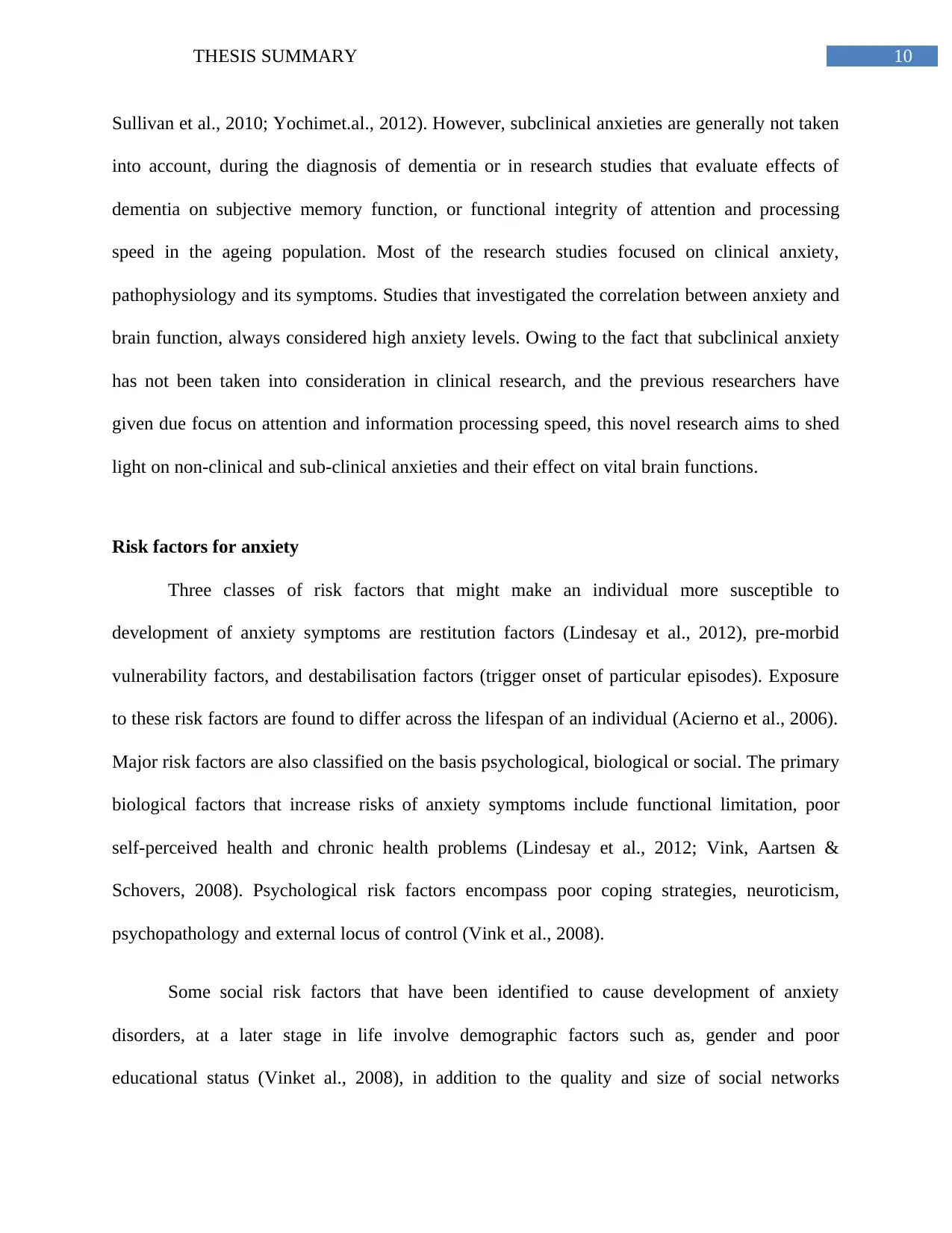
10THESIS SUMMARY
Sullivan et al., 2010; Yochimet.al., 2012). However, subclinical anxieties are generally not taken
into account, during the diagnosis of dementia or in research studies that evaluate effects of
dementia on subjective memory function, or functional integrity of attention and processing
speed in the ageing population. Most of the research studies focused on clinical anxiety,
pathophysiology and its symptoms. Studies that investigated the correlation between anxiety and
brain function, always considered high anxiety levels. Owing to the fact that subclinical anxiety
has not been taken into consideration in clinical research, and the previous researchers have
given due focus on attention and information processing speed, this novel research aims to shed
light on non-clinical and sub-clinical anxieties and their effect on vital brain functions.
Risk factors for anxiety
Three classes of risk factors that might make an individual more susceptible to
development of anxiety symptoms are restitution factors (Lindesay et al., 2012), pre-morbid
vulnerability factors, and destabilisation factors (trigger onset of particular episodes). Exposure
to these risk factors are found to differ across the lifespan of an individual (Acierno et al., 2006).
Major risk factors are also classified on the basis psychological, biological or social. The primary
biological factors that increase risks of anxiety symptoms include functional limitation, poor
self-perceived health and chronic health problems (Lindesay et al., 2012; Vink, Aartsen &
Schovers, 2008). Psychological risk factors encompass poor coping strategies, neuroticism,
psychopathology and external locus of control (Vink et al., 2008).
Some social risk factors that have been identified to cause development of anxiety
disorders, at a later stage in life involve demographic factors such as, gender and poor
educational status (Vinket al., 2008), in addition to the quality and size of social networks
Sullivan et al., 2010; Yochimet.al., 2012). However, subclinical anxieties are generally not taken
into account, during the diagnosis of dementia or in research studies that evaluate effects of
dementia on subjective memory function, or functional integrity of attention and processing
speed in the ageing population. Most of the research studies focused on clinical anxiety,
pathophysiology and its symptoms. Studies that investigated the correlation between anxiety and
brain function, always considered high anxiety levels. Owing to the fact that subclinical anxiety
has not been taken into consideration in clinical research, and the previous researchers have
given due focus on attention and information processing speed, this novel research aims to shed
light on non-clinical and sub-clinical anxieties and their effect on vital brain functions.
Risk factors for anxiety
Three classes of risk factors that might make an individual more susceptible to
development of anxiety symptoms are restitution factors (Lindesay et al., 2012), pre-morbid
vulnerability factors, and destabilisation factors (trigger onset of particular episodes). Exposure
to these risk factors are found to differ across the lifespan of an individual (Acierno et al., 2006).
Major risk factors are also classified on the basis psychological, biological or social. The primary
biological factors that increase risks of anxiety symptoms include functional limitation, poor
self-perceived health and chronic health problems (Lindesay et al., 2012; Vink, Aartsen &
Schovers, 2008). Psychological risk factors encompass poor coping strategies, neuroticism,
psychopathology and external locus of control (Vink et al., 2008).
Some social risk factors that have been identified to cause development of anxiety
disorders, at a later stage in life involve demographic factors such as, gender and poor
educational status (Vinket al., 2008), in addition to the quality and size of social networks
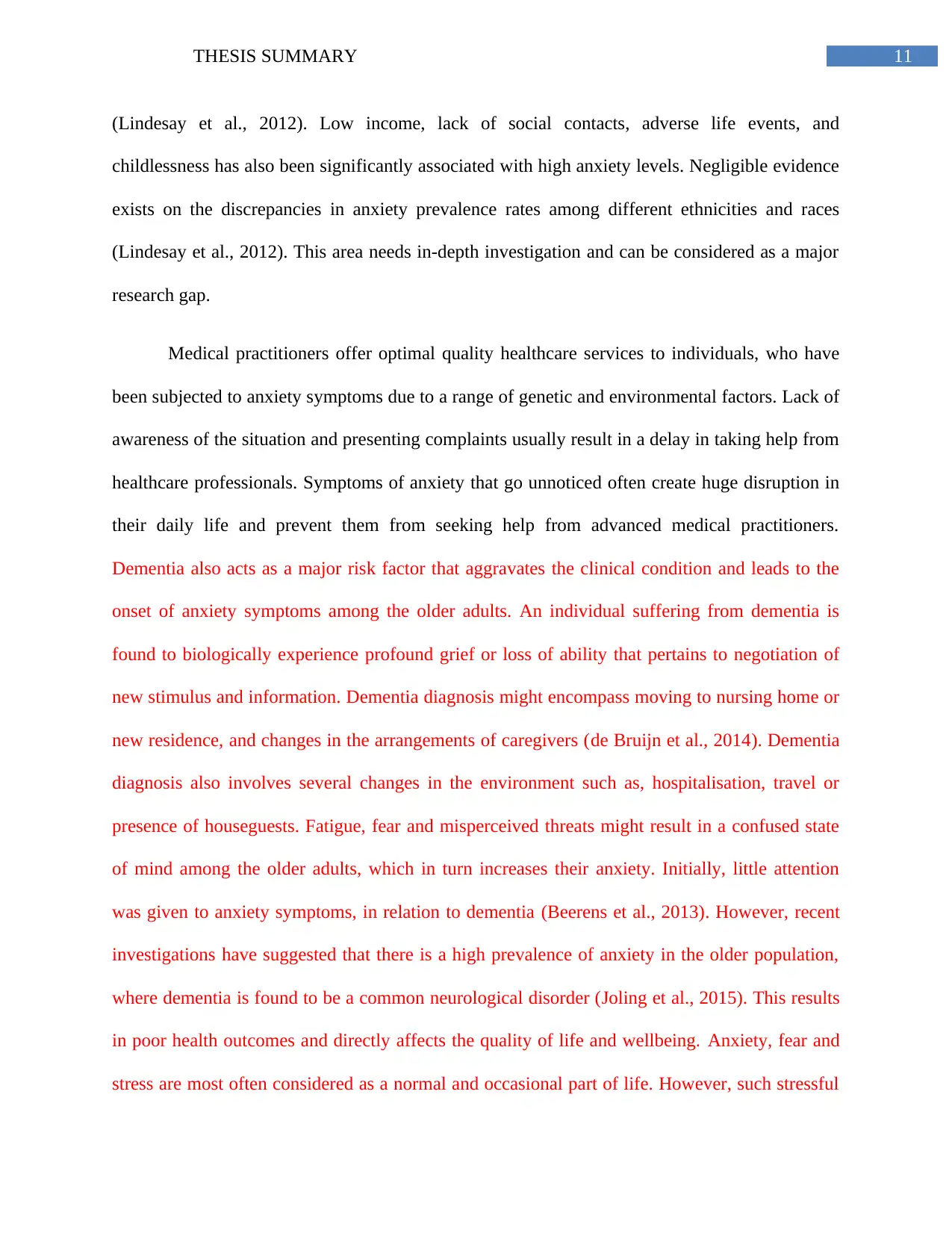
11THESIS SUMMARY
(Lindesay et al., 2012). Low income, lack of social contacts, adverse life events, and
childlessness has also been significantly associated with high anxiety levels. Negligible evidence
exists on the discrepancies in anxiety prevalence rates among different ethnicities and races
(Lindesay et al., 2012). This area needs in-depth investigation and can be considered as a major
research gap.
Medical practitioners offer optimal quality healthcare services to individuals, who have
been subjected to anxiety symptoms due to a range of genetic and environmental factors. Lack of
awareness of the situation and presenting complaints usually result in a delay in taking help from
healthcare professionals. Symptoms of anxiety that go unnoticed often create huge disruption in
their daily life and prevent them from seeking help from advanced medical practitioners.
Dementia also acts as a major risk factor that aggravates the clinical condition and leads to the
onset of anxiety symptoms among the older adults. An individual suffering from dementia is
found to biologically experience profound grief or loss of ability that pertains to negotiation of
new stimulus and information. Dementia diagnosis might encompass moving to nursing home or
new residence, and changes in the arrangements of caregivers (de Bruijn et al., 2014). Dementia
diagnosis also involves several changes in the environment such as, hospitalisation, travel or
presence of houseguests. Fatigue, fear and misperceived threats might result in a confused state
of mind among the older adults, which in turn increases their anxiety. Initially, little attention
was given to anxiety symptoms, in relation to dementia (Beerens et al., 2013). However, recent
investigations have suggested that there is a high prevalence of anxiety in the older population,
where dementia is found to be a common neurological disorder (Joling et al., 2015). This results
in poor health outcomes and directly affects the quality of life and wellbeing. Anxiety, fear and
stress are most often considered as a normal and occasional part of life. However, such stressful
(Lindesay et al., 2012). Low income, lack of social contacts, adverse life events, and
childlessness has also been significantly associated with high anxiety levels. Negligible evidence
exists on the discrepancies in anxiety prevalence rates among different ethnicities and races
(Lindesay et al., 2012). This area needs in-depth investigation and can be considered as a major
research gap.
Medical practitioners offer optimal quality healthcare services to individuals, who have
been subjected to anxiety symptoms due to a range of genetic and environmental factors. Lack of
awareness of the situation and presenting complaints usually result in a delay in taking help from
healthcare professionals. Symptoms of anxiety that go unnoticed often create huge disruption in
their daily life and prevent them from seeking help from advanced medical practitioners.
Dementia also acts as a major risk factor that aggravates the clinical condition and leads to the
onset of anxiety symptoms among the older adults. An individual suffering from dementia is
found to biologically experience profound grief or loss of ability that pertains to negotiation of
new stimulus and information. Dementia diagnosis might encompass moving to nursing home or
new residence, and changes in the arrangements of caregivers (de Bruijn et al., 2014). Dementia
diagnosis also involves several changes in the environment such as, hospitalisation, travel or
presence of houseguests. Fatigue, fear and misperceived threats might result in a confused state
of mind among the older adults, which in turn increases their anxiety. Initially, little attention
was given to anxiety symptoms, in relation to dementia (Beerens et al., 2013). However, recent
investigations have suggested that there is a high prevalence of anxiety in the older population,
where dementia is found to be a common neurological disorder (Joling et al., 2015). This results
in poor health outcomes and directly affects the quality of life and wellbeing. Anxiety, fear and
stress are most often considered as a normal and occasional part of life. However, such stressful
⊘ This is a preview!⊘
Do you want full access?
Subscribe today to unlock all pages.

Trusted by 1+ million students worldwide
1 out of 34
Related Documents
Your All-in-One AI-Powered Toolkit for Academic Success.
+13062052269
info@desklib.com
Available 24*7 on WhatsApp / Email
![[object Object]](/_next/static/media/star-bottom.7253800d.svg)
Unlock your academic potential
Copyright © 2020–2025 A2Z Services. All Rights Reserved. Developed and managed by ZUCOL.





